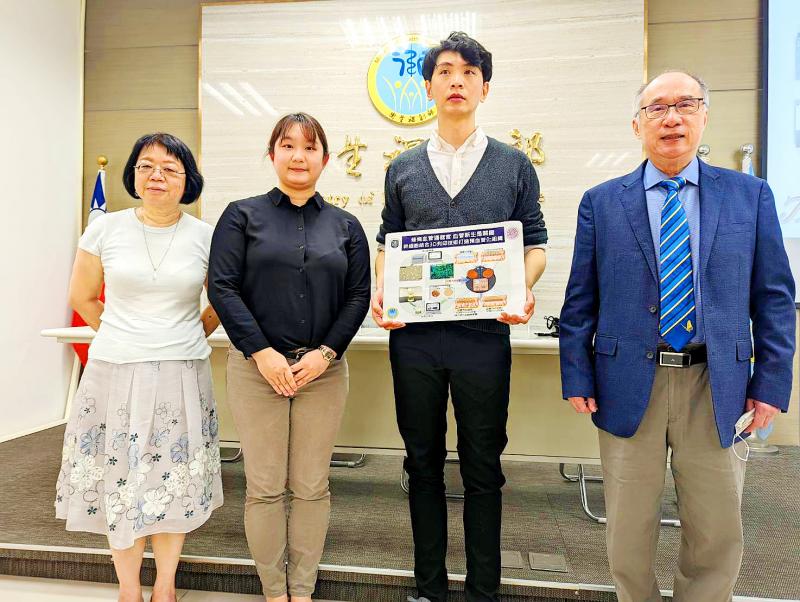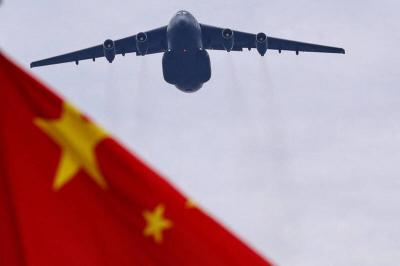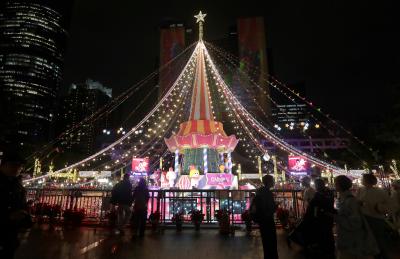The National Health Research Institutes (NHRI) yesterday said its researchers had engineered a novel vascular construct of a stem cell-laden 3D-printed scaffold that can enhance tissue revascularization.
As restoring or replacing a malfunctioning human organ is very difficult and waiting for a suitable organ for a transplant can take a long time, transplantable engineered tissue is highly sought after, but its development has been hampered by the lack of a vascular network within the engineered tissue.
The research team manufactured a novel 3D architecture scaffold with poly(glycerol sebacate) acrylate (PGSA), serving as a functional and transplantable vascular construct, which provides an innovative alternative therapeutic strategy for vascular tissue engineering, and could possibly be used to treat ischemic disease and for organ transplants.

Photo: Wu Liang-yi, Taipei Times
The research team is led by NHRI Institute of Cellular and System Medicine director Yet Shaw-fang (林秀芳) and Jane Wang (王潔), an associate professor at National Tsing Hua University’s Department of Chemistry.
To repair or regenerate ischemic tissues, revascularization is essential to support the delivery of oxygen and nutrients to the cells and to clear waste products, Jiang Wei-cheng (蔣偉程), a postdoctoral fellow at the NHRI Institute of Cellular and System Medicine, said yesterday.
One of the more recent strategies is “prevascularization,” or forming microvascular networks within the tissue construct before implantation, Jiang said.
However, a major challenge during development is insufficient cell supply in the initial stage prior to implantation, he said, adding that another challenge is selecting the biomaterial and the architecture scaffold for the development of an efficient and effective vascular construct.
Jiang said the team took a regenerative engineering approach by taking stem cells and utilizing a digital light processing system to manufacture a recently designed novel 3D-printed architecture scaffold with PGSA, to be used for the generation of novel vascular constructs.
Transplantation of the vascular construct in wounded mice resulted in the formation of a new vascular network that integrated into the existing vasculature of the host tissue, leading to revascularization and enhanced blood perfusion at the implant site, Lin said.
The technology for engineering the vascular construct could be further developed to help treat diseases, such as peripheral arterial disease in people with diabetes or another ischemic disease, she said, adding that it could also be used for organ transplants, drug testing, or in vitro tissue or organ engineering.
The team’s study was published by the journal Biofabrication in July last year, the NHRI said.

Beijing could eventually see a full amphibious invasion of Taiwan as the only "prudent" way to bring about unification, the US Department of Defense said in a newly released annual report to Congress. The Pentagon's "Annual Report to Congress: Military and Security Developments Involving the People's Republic of China 2025," was in many ways similar to last year’s report but reorganized the analysis of the options China has to take over Taiwan. Generally, according to the report, Chinese leaders view the People's Liberation Army's (PLA) capabilities for a Taiwan campaign as improving, but they remain uncertain about its readiness to successfully seize

Taiwan is getting a day off on Christmas for the first time in 25 years. The change comes after opposition parties passed a law earlier this year to add or restore five public holidays, including Constitution Day, which falls on today, Dec. 25. The day marks the 1947 adoption of the constitution of the Republic of China, as the government in Taipei is formally known. Back then the Chinese Nationalist Party (KMT) governed China from Nanjing. When the KMT, now an opposition party in Taiwan, passed the legislation on holidays, it said that they would help “commemorate the history of national development.” That

Taiwan has overtaken South Korea this year in per capita income for the first time in 23 years, IMF data showed. Per capita income is a nation’s GDP divided by the total population, used to compare average wealth levels across countries. Taiwan also beat Japan this year on per capita income, after surpassing it for the first time last year, US magazine Newsweek reported yesterday. Across Asia, Taiwan ranked fourth for per capita income at US$37,827 this year due to sustained economic growth, the report said. In the top three spots were Singapore, Macau and Hong Kong, it said. South

Snow fell on Yushan (Jade Mountain, 玉山) yesterday morning as a continental cold air mass sent temperatures below freezing on Taiwan’s tallest peak, the Central Weather Administration (CWA) said. Snowflakes were seen on Yushan’s north peak from 6:28am to 6:38am, but they did not fully cover the ground and no accumulation was recorded, the CWA said. As of 7:42am, the lowest temperature recorded across Taiwan was minus-5.5°C at Yushan’s Fengkou observatory and minus-4.7°C at the Yushan observatory, CWA data showed. On Hehuanshan (合歡山) in Nantou County, a low of 1.3°C was recorded at 6:39pm, when ice pellets fell at Songsyue Lodge (松雪樓), a